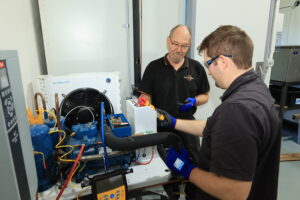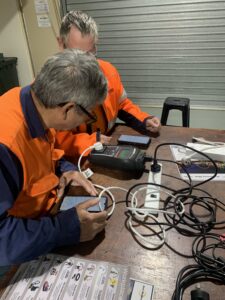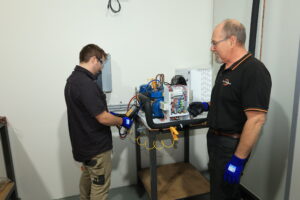Air conditioners are some of the world’s most common appliances. These systems are based on simple principles, but they rely on specific chemical compounds to function properly.
Refrigerants are the chemicals used to absorb and remove heat in the spaces where air conditioners, fridges, freezers and other heat pump systems are used. Like many chemicals, refrigerants are subject to strict legislation regarding their handling and storage.
In this article, we’ll discuss everything you need to know about working with refrigerants and why they’re tightly regulated within Australia.

Introduction to Refrigerants
Refrigerants are a class of chemicals that are used to transfer heat in air conditioning systems, refrigeration and heat pumps. We use these particular chemicals because they have excellent heat capacity. They can also undergo repeated transitions between their liquid and gas state without breaking down.
Some of the other key attributes of an effective refrigerant include:
- Non-flammable
- Low boiling point
- High critical temperature (the temperature where a gas can no longer be liquefied)
- Non-corrosive
- Non-toxic (although this hasn’t always been the case)
While refrigerants are common, these chemicals can be toxic and harmful to the environment, so their handling is closely regulated.
Common Types of Refrigerant
There are thousands of substances that have been used as refrigerants over the years. They’re broken into five major categories:
- Chlorofluorocarbon (CFCs) – CFCs are the original class of refrigerant chemical. These were widely used in air conditioning and refrigeration for decades before their environmental impact was noted and they were phased out. Common CFCs include:
- R-11 (Freon)
- R-12
- R-123
- R-502
- Hydrochlorofluorocarbon (HCFCs) – The phase-out of CFCs increased the popularity of HCFCs. Most HCFCs have a much lower environmental impact than CFCs, but they have also been phased out. Common HCFCs include:
- R-22
- R-123
- Hydrofluorocarbons (HFCs) – HFCs are a lower-impact alternative to CFCs and HCFCs. Despite their reduced impact, HFCs are known to have contributed to global warming, and production is currently scaling down. Common HFCs include:
- R-134a
- R-23
- R-32
- R-407A/C
- Low GWP HFCs – Low Global Warming Potential (GWP) HFCs offer a lower environmental impact and improved performance. Common Low GWP HFCs include:
- R-290 (Propane)
- R-744 (Carbon Dioxide)
- R-717 (Ammonia)
- Very Low GWP HFOs – As the role of Hydrofluorocarbons (HFCs) is phased-down, HFOs can ensure systems maintain their safety and energy efficiency while still being an economical alternative. These refrigerants include:
- R-1234yf
The Environmental Impact of Refrigerant
The regulations surrounding refrigerant handling are largely due to their environmental impact. In the early 1980s, scientists discovered that CFCs were doing serious damage to the ozone layer.
When released into the atmosphere, CFCs (and HFCs to a lesser degree) are known to break down and react with the ozone layer, which depletes earth’s protection against UV rays.
The problem was so severe that the UN signed the Montreal Protocol in 1987. Under the terms of the protocol, member countries rapidly phased out CFCs.
Today, the Montreal Protocol is still in effect, and it’s regularly updated. The current terms of the protocol aim to phase out HCFCs and HFCs in favour of Low-GWP (Global Warming Potential) HFCs and Very Low GWP HFOs.
Potential Hazards When Working With Refrigerants
Many CFCs, HCFCs and HFCs are highly toxic to humans and animals. While refrigerant poisoning is rare, these chemicals can have a serious impact on the health of anyone who handles them regularly.
Exposure to refrigerant chemicals can cause a variety of mild symptoms, including:
- Irritation (particularly to the eyes, throat and lungs)
- Headaches and dizziness
- Nausea and vomiting
- Chemical burns and frostbite
In severe cases, refrigerant poisoning can also cause:
- Buildups of fluid in the lungs
- Bleeding in the lungs
- Unconsciousness
- Seizures
- Dangerous and irregular heart beats
- Coughing or vomiting up blood
Do I Need a Licence to Handle and Recover Refrigerants?
The environmental impact and health risk of refrigerant chemicals means you need an appropriate licence for handling and recovery. In Australia, you need a Refrigerant Handling Licence from the Australian Refrigeration Council (ARC) if you want to:
- Handle refrigerant
- Recover refrigerant
- Work on air conditioning and refrigeration equipment equipment
- Work on automotive air conditioning and refrigeration equipment
- Undertake refrigeration and air conditioning training
ARC issues multiple classes of licence depending on your qualifications, the equipment you’re servicing, and whether you need to recover refrigerant as part of your ordinary duties.
Learn More About Working With Refrigerants at Get Skilled Training!
Refrigerants are some of the widely-used chemicals in the world. They also pose a risk through improper handling, so you’ll need an appropriate licence if you want to install, service or repair air conditioning systems.
Get Skilled Training is an RTO that provides air conditioning courses to students across Australia. Our training programs include hands-on training so you can develop the skills you need to advance your career.
If you’re an electrician wanting to install split systems, or an aspiring refrigeration mechanic, we can help you take the next step! Visit our website to enrol in a course, or contact us to find out more about Cert II and Cert III air conditioning training.




